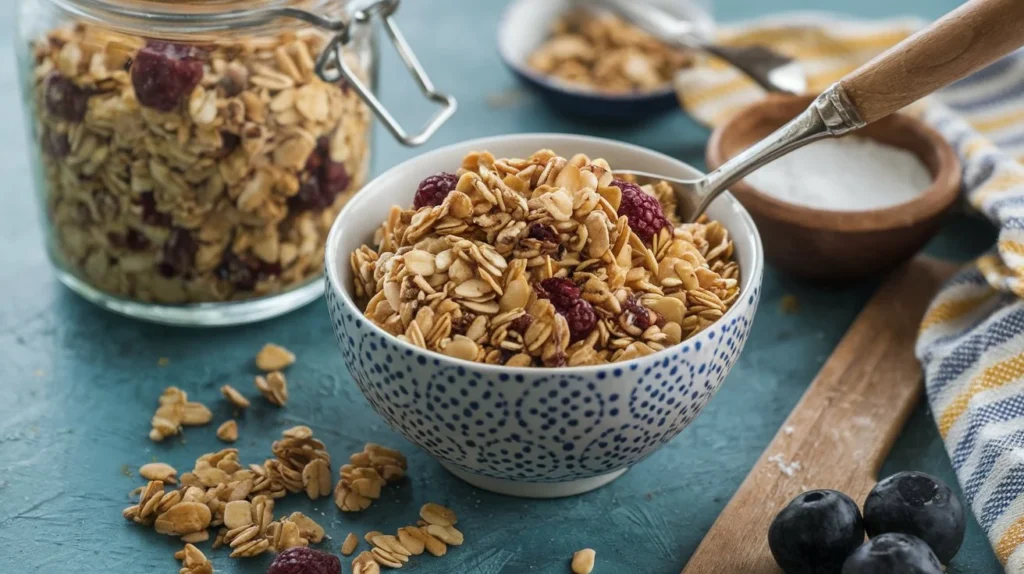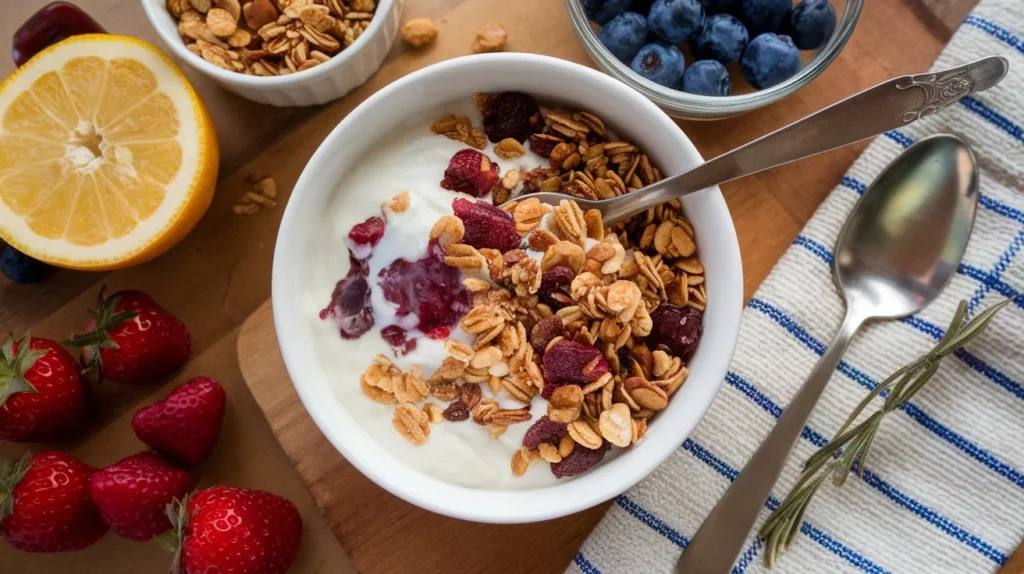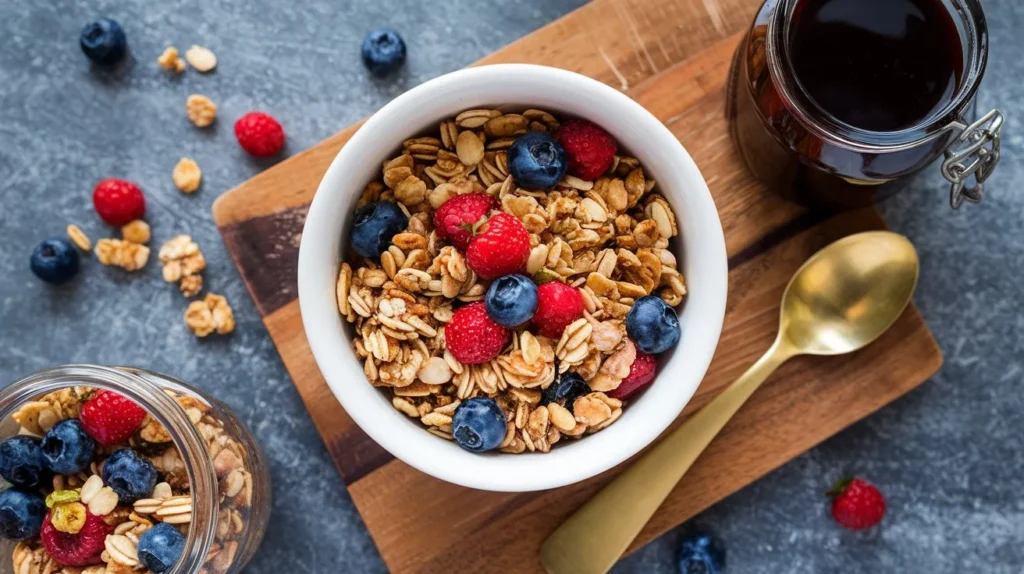What Is Granola Made Of? A Delicious & Easy Recipe Guide
Granola has become a staple for many health-conscious eaters, offering a satisfying crunch paired with sweet and savory flavors. But what is granola made of recipe? This versatile breakfast delight often features a mix of whole grains, nuts, seeds, and natural sweeteners, baked to perfection. Not only is homemade granola easy to prepare, but it also allows full control over ingredients, making it healthier than many store-bought options.
In this comprehensive guide, you’ll learn exactly what goes into making granola, step-by-step preparation, and how to customize it to suit your taste and dietary needs. Let’s dive into the first part of our granola journey!
Introduction to Granola
Granola is a popular breakfast and snack option celebrated for its nutritional benefits and customizable ingredients. Traditionally, it consists of rolled oats, nuts, seeds, sweeteners, and dried fruits—all baked together for a delightful crunch.
But why has granola gained such popularity? It’s not just about taste. Granola is loaded with fiber, healthy fats, and essential vitamins, making it a powerhouse for sustained energy. Plus, it’s perfect for busy mornings or an on-the-go snack.
The Origin of Granola
Granola has a rich history dating back to the late 19th century when it was developed as a health food. Originally called granula, it has since evolved into the crispy, sweetened cereal we know today.
Why Make Granola at Home?
Store-bought granola often contains excessive sugar and preservatives. Crafting your own homemade granola recipe lets you:
- Control sugar levels
- Avoid artificial preservatives
- Customize flavors and textures
- Ensure dietary preferences (vegan, gluten-free, nut-free)
Granola’s Versatility in Meals
This crunchy delight isn’t just for breakfast! Granola pairs wonderfully with:
- Yogurt and fresh fruit for a balanced breakfast
- Smoothie bowls as a crunchy topping
- Trail mix for a quick snack
- Dessert parfaits and ice cream add-ons
Granola’s endless possibilities make it a kitchen must-have!
Core Ingredients of Granola

Creating the perfect granola recipe starts with a thoughtful blend of wholesome ingredients. Each component plays a crucial role in balancing flavor, texture, and nutritional value. Let’s break down the essential ingredients you’ll need for homemade granola.
Rolled Oats: The Foundation of Granola
The heart of nearly every granola recipe, rolled oats provide the base for this delicious cereal. These whole grains offer a chewy texture and mild nutty flavor while being rich in fiber, particularly beta-glucan, which supports heart health and digestion.
Why use rolled oats instead of quick oats? Rolled oats retain their structure better during baking, resulting in a chunkier, crispier granola. Meanwhile, quick oats may become mushy or powdery, compromising the desired texture.
Nutritionally, oats deliver essential minerals like magnesium and iron, alongside antioxidants, making them a powerhouse ingredient in your granola mix.
Nuts and Seeds: Adding Crunch and Nutrition
Nuts and seeds are the stars when it comes to texture and nutritional boosts. They provide a satisfying crunch while packing healthy fats, protein, and essential vitamins.
Popular Nut Choices:
- Almonds – Rich in vitamin E and healthy fats
- Walnuts – High in omega-3 fatty acids
- Pecans – Loaded with antioxidants
Popular Seeds for Granola:
- Pumpkin Seeds (Pepitas) – Iron and magnesium-rich
- Sunflower Seeds – High in vitamin E and selenium
- Chia Seeds & Flaxseeds – Great for omega-3s and fiber
Besides the nutritional value, nuts and seeds contribute to the crunchy granola clusters many people love. Roasting them with the oats enhances their natural flavors.
Pro Tip: Chop larger nuts into smaller pieces to ensure even distribution throughout the mix.
Sweeteners: Natural Options for Flavor and Binding
Sweeteners play a dual role—they add sweetness while binding ingredients together for those delightful granola clusters.
The best options for sweeteners in granola are natural and minimally processed, keeping the recipe wholesome:
- Honey – A natural humectant that adds moisture and mild sweetness
- Maple Syrup – Vegan-friendly with a deep, caramel-like flavor
- Agave Nectar – Mildly sweet and perfect for vegan recipes
Not only do these sweeteners provide taste, but they also help caramelize the oats and nuts, giving granola its signature golden-brown hue.
Tip: Avoid using granulated sugar, as it lacks the binding properties necessary for creating clusters.
Fats: Enhancing Crispiness and Flavor
Fats are essential for giving homemade granola its irresistible crunch and helping the flavors meld together. Healthy oils coat the dry ingredients, preventing them from burning while adding richness.
Best Fats for Granola:
- Coconut Oil – Imparts a subtle tropical flavor while boosting crispiness
- Olive Oil – A heart-healthy option with a mild, savory note
- Avocado Oil – Neutral in flavor and rich in monounsaturated fats
Using the right fat not only enhances the texture but also improves nutrient absorption, as fats help the body absorb fat-soluble vitamins like A, D, E, and K.
Dried Fruits: Natural Sweetness and Chewiness
Dried fruits add a burst of natural sweetness and a chewy contrast to the crispiness of the oats and nuts. They also introduce essential vitamins, minerals, and antioxidants.
Popular Dried Fruits for Granola:
- Raisins – Naturally sweet with a chewy texture
- Cranberries – Slightly tart, balancing the granola’s sweetness
- Apricots – Chewy and mildly tangy
- Dates and Figs – Rich in natural sugars and fiber
When to Add Dried Fruits:
Always mix dried fruits into the granola after baking. Baking them can lead to burning, making them hard and bitter.
Together, these core ingredients form the perfect foundation for a healthy homemade granola recipe. Next, we’ll walk through the step-by-step process of making your own granola at home!
Step-by-Step Granola Recipe

Making homemade granola is surprisingly simple, requiring just a handful of ingredients and basic kitchen tools. Follow this granola recipe step by step for perfect results every time.
Preparation: Gather Ingredients and Preheat the Oven
Before diving into the mixing process, proper preparation is key to success. Start by gathering all the necessary ingredients:
- Rolled oats
- Mixed nuts and seeds (e.g., almonds, walnuts, pumpkin seeds)
- Natural sweeteners like honey or maple syrup
- Healthy oils such as coconut oil or olive oil
- Dried fruits (e.g., raisins, cranberries)
- Spices (like cinnamon or nutmeg)
- Pinch of salt for flavor balance
Preheat your oven to 325°F (165°C) and line a large baking sheet with parchment paper. Using parchment prevents sticking and ensures easy cleanup.
Pro Tip: Pre-measuring your ingredients saves time and prevents errors during the process.
Mixing Dry Ingredients: The Flavor Base
The dry ingredients form the core structure and texture of your granola recipe. In a large mixing bowl, combine:
- 3 cups rolled oats
- 1 cup chopped nuts and seeds (e.g., almonds, sunflower seeds)
- 1 tsp ground cinnamon
- 1/4 tsp salt
Stir the dry ingredients thoroughly, ensuring the spices and salt are evenly distributed.
Why Add Salt? A pinch of salt balances the sweetness and enhances the overall flavor.
Optional Add-ins:
- Add 1 tbsp chia seeds or flaxseeds for extra fiber and omega-3s.
- For a chocolate twist, mix in 2 tbsp cocoa powder.
Incorporating Wet Ingredients: Binding and Sweetening
The wet ingredients help bind everything together while adding sweetness and richness. In a separate bowl or small saucepan, blend together:
- 1/3 cup coconut oil (melted)
- 1/2 cup maple syrup or honey
- 1 tsp vanilla extract (optional)
Whisk the mixture until well combined and smooth. If the coconut oil has solidified, gently heat it on low until it liquefies.
Next, pour the wet mixture over the dry ingredients in the bowl. Using a spatula or your hands, mix thoroughly until every oat, nut, and seed is evenly coated. This step ensures proper caramelization and clustering during baking.
Baking Process: Achieving the Perfect Crisp
Proper baking technique is what transforms a bowl of oats into a crunchy, golden-brown granola masterpiece.
Steps for Baking:
- Spread the granola mixture evenly on the prepared baking sheet. Use the back of a spoon or spatula to press it down slightly for larger clusters.
- Bake at 325°F (165°C) for 20-25 minutes, stirring halfway through for even browning.
- Avoid over-stirring if you prefer chunkier granola.
Pro Tip: If you like extra crunchy granola, bake for an additional 5 minutes, keeping a close eye to prevent burning.
You’ll know it’s done when the edges turn golden brown, and a nutty aroma fills your kitchen.
Adding Dried Fruits: Sweet Chewy Goodness
Dried fruits bring natural sweetness and a pleasant chewiness to the granola. However, they burn easily during baking, so it’s best to add them afterward.
Once the granola has finished baking and is still warm but not hot, stir in about 1 cup of dried fruits, such as:
- Raisins
- Cranberries
- Chopped apricots
- Chopped dates or figs
Feel free to mix and match to suit your taste.
Cooling and Storage: Locking in Freshness
Cooling granola properly is essential to maintain its crispiness.
- Allow the granola to cool completely on the baking sheet. This allows it to crisp up further as it cools.
- Once cooled, transfer to an airtight container or mason jar.
Storage Tips:
- Store at room temperature for up to 2 weeks.
- For long-term storage, freeze in an airtight bag for up to 3 months.
Customizing Your Granola
One of the best things about homemade granola is its endless versatility. Whether you prefer a classic mix or want to experiment with unique flavors and textures, granola can easily be adapted to your preferences. Let’s explore how you can customize your granola recipe to make it truly your own.
Flavor Variations for a Personalized Touch
Adding new flavors can completely transform your granola experience. Whether you’re craving something chocolatey, fruity, or spiced, these additions can elevate the taste:
- Cocoa Powder: Stir in 2 tablespoons of unsweetened cocoa powder for a chocolate-flavored granola.
- Vanilla Extract: A teaspoon of pure vanilla extract adds warmth and enhances sweetness.
- Citrus Zest: Grated orange or lemon zest brings a refreshing, tangy twist.
- Spices: Experiment with ground ginger, nutmeg, or cardamom for aromatic depth.
- Coconut Flakes: For a tropical vibe, add unsweetened shredded coconut during the last 5 minutes of baking.
Pro Tip: Try combining flavors, such as cocoa powder with cinnamon for a Mexican hot chocolate twist or vanilla with orange zest for a bright, citrusy blend.
Dietary Adjustments for Different Needs
Granola can be tailored to fit nearly every diet. Whether you’re vegan, gluten-free, or nut-free, here’s how to adjust the recipe:
Vegan Granola:
- Replace honey with maple syrup or agave nectar.
- Use coconut oil instead of butter.
Gluten-Free Granola:
- Choose certified gluten-free rolled oats to avoid cross-contamination.
- Double-check dried fruits and other add-ins for gluten-free labeling.
Nut-Free Granola:
- Swap nuts for seeds like pumpkin seeds, sunflower seeds, or chia seeds.
- Use coconut flakes for additional crunch without allergens.
Low-Sugar Granola:
- Reduce the sweetener quantity or use monk fruit or stevia.
- Increase spices and vanilla extract to compensate for lower sweetness.
By making these minor swaps, you can create a granola recipe suited for various dietary preferences without sacrificing flavor.
Texture Preferences: Clumpy vs. Loose Granola
Texture plays a key role in how you enjoy granola. Some love chunky clusters, while others prefer a looser, evenly spread mix. Here’s how to control the texture:
For Chunkier Granola:
- Press the mixture firmly onto the baking sheet before baking.
- Avoid stirring during the first half of the baking time.
- Use extra sweeteners and fats for better binding.
For Loose, Even Granola:
- Stir the granola every 10 minutes during baking.
- Use slightly less oil and sweetener.
Clumpier Granola Pro Tip:
- Add 1 whipped egg white to the wet ingredients. It acts as a natural binder, creating extra-large clusters.
Serving Suggestions: Creative Ways to Enjoy Granola
Granola isn’t just for breakfast—it can be a versatile addition to many dishes. Try these creative serving ideas:
- Yogurt Parfait: Layer granola with Greek yogurt and fresh berries.
- Smoothie Bowl: Sprinkle on top for crunch in a blended fruit bowl.
- Milk & Granola: Enjoy with almond, oat, or regular milk for a classic cereal bowl.
- Dessert Topping: Use it on top of fruit crisps or ice cream for added crunch.
- Trail Mix: Mix granola with dark chocolate chips and extra dried fruits for a portable snack.
Granola’s flexibility makes it perfect for any time of day!

Frequently Asked Questions (FAQs)
What are the health benefits of homemade granola?
Homemade granola is a nutrient-dense option rich in fiber, healthy fats, and essential vitamins. By making it yourself, you avoid excess sugars and preservatives commonly found in store-bought versions. The combination of oats, nuts, and seeds supports heart health, aids digestion, and provides sustained energy.
How can I make my granola clumpier?
For larger clusters, press the granola firmly onto the baking sheet before baking and avoid stirring too frequently. Adding extra sweeteners like honey or a whipped egg white also helps create stronger bonds between the ingredients.
Can I substitute fresh fruit for dried fruit in granola?
Fresh fruit contains moisture, which can cause the granola to spoil quickly. It’s best to use dried fruits during preparation and add fresh fruit like blueberries or banana slices right before serving.
How long does homemade granola last?
When stored in an airtight container at room temperature, homemade granola stays fresh for up to two weeks. For longer storage, freeze it for up to three months without compromising taste or texture.
Is granola gluten-free?
Granola can be gluten-free if made with certified gluten-free oats and other gluten-free ingredients. Always check labels, especially for pre-packaged oats and dried fruits, to ensure they meet gluten-free standards.
Can I reduce the sugar content in granola?
Absolutely! You can lower sugar by reducing the sweetener amount or using alternatives like monk fruit sweetener or coconut sugar. Boost natural flavors with spices, vanilla extract, and citrus zest to compensate for lower sweetness.
Conclusion
Crafting your own granola recipe at home offers endless possibilities for personalization, ensuring it suits your taste, health goals, and dietary preferences. By understanding the core ingredients and mastering the step-by-step process, you can create a healthy, flavorful, and versatile snack for any occasion.
Whether you prefer a classic oat and nut blend or want to explore bold flavors like cocoa and cinnamon, homemade granola is a delightful, wholesome addition to your pantry. So grab your ingredients, preheat the oven, and enjoy the satisfaction of making your own perfect batch of granola today!








